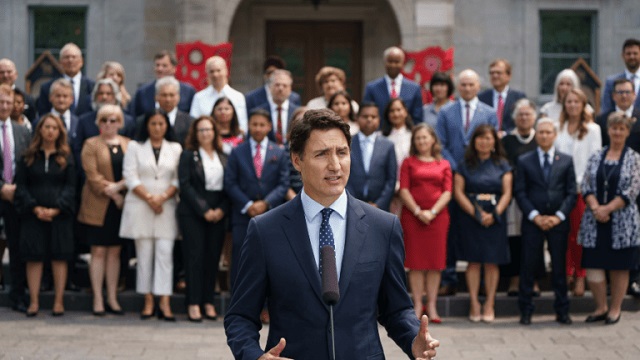National
Liberal Patronage: $330 Million in Questionable Allocations at Canada’s Green Tech Agency

What we learned from the committee is as clear as it is disturbing: Liberal ministers and appointees at SDTC have been funneling taxpayer dollars to friends under the guise of green technology funding.
In a damning House of Commons Public Accounts Committee (PACP) meeting, details emerged that Canada’s flagship “green” agency, Sustainable Development Technology Canada (SDTC), funneled hundreds of millions of taxpayer dollars into companies connected to Liberal insiders. An Auditor General’s report shed light on the staggering scale of this apparent Liberal patronage scheme, revealing that $330 million was awarded to projects with board members tied to the SDTC itself. Another $59 million found its way into initiatives that didn’t even meet SDTC’s green-tech mandate, fueling accusations of political favoritism and cronyism within Prime Minister Trudeau’s government.
Opposition MPs, led by Conservatives Rick Perkins and Michael Cooper, along with Bloc MP Nathalie Sinclair-Desgagné and NDP MP Richard Cannings, took turns dissecting former Liberal Minister Navdeep Bains’ role in appointing Annette Verschuren as SDTC’s board chair. Testimony from the hearing, corroborated by statements from SDTC’s CEO, revealed that Bains reached out to Verschuren multiple times about her appointment, despite his claims of following an “open, transparent, and arm’s-length” process. Yet, when grilled by the opposition, Bains repeatedly invoked “process” and shifted blame onto the Privy Council Office (PCO), claiming he merely encouraged a diverse pool of applicants.
But the evidence doesn’t line up with the former minister’s narrative. Witnesses testified that Assistant Deputy Minister Noseworthy had informed SDTC CEO Leah Lawrence of Verschuren’s appointment even before it was finalized, indicating a behind-the-scenes process driven by Liberal influence. These revelations throw the credibility of the appointment process into question, suggesting it may have been less about selecting qualified candidates and more about ensuring loyal Liberal allies held key positions.
The committee’s findings, sparked by the Auditor General’s investigation, expose a serious issue of conflicts of interest within SDTC’s funding operations. This is a public agency with a mission to advance sustainable development, yet the Liberal government’s management seems to have turned it into a cash machine for insiders. The Auditor General’s report has revealed a troubling pattern of funding allocations going to companies with board connections, undercutting the government’s credibility on environmental stewardship and transparency.
What we learned from the committee is as clear as it is disturbing: Liberal ministers and appointees at SDTC have been funneling taxpayer dollars to friends under the guise of green technology funding. This isn’t just a lapse in oversight; it’s a systematic approach that prioritizes insider deals over real environmental progress, putting the Trudeau government’s commitment to transparency and sustainability squarely in doubt.
Opposition MPs Call Out Lack of Accountability
During this pivotal Public Accounts Committee meeting, opposition MPs went on the offensive, exposing a deep pattern of evasion and mismanagement in how taxpayer dollars were funneled into the hands of Liberal insiders under former Liberal Minister Navdeep Bains. Conservative MPs Rick Perkins and Michael Cooper led the charge, calling out Bains’ deflections and demanding straight answers. They pointed to the $330 million awarded by Sustainable Development Technology Canada (SDTC) to projects connected to its own board members, questioning why this blatant conflict of interest was permitted under Bains’ watch.
Perkins and Cooper’s approach was blunt. They challenged Bains on his repeated reliance on vague, bureaucratic defenses, pointing out that as minister, he had a duty to exercise oversight on SDTC’s operations. Perkins in particular questioned Bains about his involvement in appointing Annette Verschuren as chair of SDTC’s board. Despite Bains’ claims that he couldn’t “recall” specific discussions with Verschuren, evidence surfaced that he contacted her multiple times prior to her appointment. For Perkins and Cooper, this level of involvement, coupled with Bains’ repeated refusal to acknowledge conflicts of interest within SDTC, painted a damning picture of a Liberal minister who prioritized insider appointments over accountability to Canadian taxpayers.
Bloc MP Nathalie Sinclair-Desgagné and NDP MP Richard Cannings focused their questioning on the government’s failure to ensure responsible oversight of SDTC’s environmental funds. Sinclair-Desgagné highlighted Bains’ “arm’s-length” defense as an excuse, given the testimony indicating that senior officials had preemptively informed SDTC’s CEO about Verschuren’s appointment, suggesting an internal network of influence rather than a transparent, merit-based process. She called out the apparent detachment of Bains from SDTC’s operations, underscoring how his office either ignored or bypassed red flags.
NDP MP Cannings raised critical points about the hypocrisy of a government that claims to champion green innovation while allowing SDTC to devolve into a taxpayer-funded favor bank. Cannings pointed out that SDTC’s funds, meant for real environmental progress, were instead granted to projects with questionable ties and little sustainability impact. For Canadians concerned with climate action, Cannings’ questions laid bare the truth: the Liberal government’s commitment to “green” initiatives is far weaker than their dedication to keeping insiders funded.
This unified front by Conservative, Bloc, and NDP MPs highlighted the same disturbing trend: a Liberal government that talks about accountability and climate action but delivers neither, choosing instead to use taxpayer funds to benefit those closest to the party.
Bains’ Defense: Hiding Behind “Process” and Arm’s-Length Excuses
When faced with tough questions on SDTC’s mismanagement, former Liberal Minister Navdeep Bains clung tightly to procedural defenses, repeatedly deflecting responsibility to the Privy Council Office (PCO) and downplaying his role as minister. Bains insisted that the PCO alone was responsible for vetting board members, suggesting his involvement was “hands-off” and strictly procedural. Yet, opposition MPs saw right through this tactic, viewing it as a clear attempt to dodge accountability.
Throughout the hearing, Bains deflected pointed questions by portraying SDTC’s oversight as out of his hands, claiming his office only followed standard processes. He avoided addressing why his appointee, Annette Verschuren, landed the SDTC board chair role despite potential conflicts of interest, with millions later flowing to companies linked to board members. By painting himself as a mere bystander to PCO’s vetting process, Bains sidestepped responsibility for ensuring taxpayer funds went to projects with genuine environmental merit, rather than those benefiting Liberal insiders.
When pressed about specific discussions surrounding Verschuren’s appointment, Bains leaned on what can only be described as selective memory. Asked about his personal involvement, he claimed he “couldn’t recall” multiple key conversations — a response that only raised eyebrows among committee members. Testimonies from SDTC’s CEO and other witnesses indicated Bains contacted Verschuren several times, yet his failure to acknowledge this directly cast doubt on his narrative of impartial oversight.
Opposition MPs argued that Bains’ procedural evasions were thinly veiled attempts to cover for what looks like a Liberal patronage pipeline. His refusal to answer clearly and his dependence on “I don’t recall” responses drew sharp criticism, with opposition leaders labeling it as a standard Liberal tactic to avoid admitting responsibility. The result? A testimony that shed little light on how SDTC was run but spoke volumes about the government’s willingness to dodge accountability whenever insiders are involved.
Inclusion and “Transparency” Won’t Save Liberals from Accountability
Throughout the Public Accounts Committee hearing, Liberal MPs Jean Yip and Francis Drouin took on a clear mission: protect Navdeep Bains at all costs. Instead of addressing the mountain of allegations around SDTC’s blatant cronyism and taxpayer waste, Yip and Drouin turned the hearing into a platform for Liberal talking points, spinning tales of “transparency” and “diversity” that conveniently dodged the actual corruption in front of them. Let’s be clear: hiding behind “inclusivity” doesn’t make the Liberals less corrupt, nor does it absolve them of responsibility when taxpayer money is at stake.
Jean Yip’s questioning gave Bains endless opportunities to recite the “open and competitive” process that supposedly led to Annette Verschuren’s appointment as SDTC board chair. Yet she never asked about Verschuren’s Liberal ties, or why so many millions were awarded to companies connected to SDTC board members. Yip’s focus on “inclusion” and “diverse voices” on the board was a distraction — a slick attempt to shift attention away from the Auditor General’s findings and avoid the reality that those “diverse voices” are well-connected Liberal insiders benefiting from your money.
Francis Drouin was right there to keep the narrative going, pivoting to SDTC’s supposed “green mandate” and giving Bains a platform to tout his government’s commitment to sustainability. But let’s call it what it is: a cover. By talking up sustainability and diversity, Drouin helped Bains avoid explaining why SDTC mismanaged $330 million on projects tied to its own board members, and why an additional $59 million went to ineligible initiatives. This wasn’t accountability — it was damage control, plain and simple.
Yip and Drouin’s interventions were textbook Liberal tactics: deflect, divert, and dilute the discussion. They may have repeated “transparency” and “inclusivity” all they wanted, but these buzzwords are nothing more than a smokescreen for taxpayer-funded favoritism. For Canadians watching, it was an unmistakable display of damage control — the Liberals doing everything they can to dodge real accountability while your tax dollars keep flowing to their inner circle.
Broader Implications: A Systemic Liberal Culture of Avoiding Accountability
The revelations from this Public Accounts Committee meeting show us something far darker than the mismanagement of a single agency. They expose a deeply entrenched system where Trudeau’s Liberal government doesn’t just waste taxpayer money — they use it to reward political cronies and shield insiders from accountability. This isn’t just negligence; it’s the Trudeau Swamp in action, a well-oiled machine funneling your money to friends and allies under the thin cover of bureaucratic “process.”
At the center of this scandal is a strategy the Liberals have perfected: hide behind procedural jargon and “arm’s-length” defenses to dodge any responsibility. The moment former Minister Navdeep Bains took the stand, you could see the tactics at work. Facing questions on how Sustainable Development Technology Canada (SDTC) turned into a cash cow for Liberal insiders, Bains and his fellow Liberal MPs defaulted to the same tired script — insisting every questionable allocation, every insider appointment, was just “routine process.” They claim “independence,” they claim “transparency,” but the evidence paints a different picture: Liberal insiders filling key roles and pulling the strings to channel your money into their pockets.
This scandal isn’t an isolated incident. It’s a glimpse into a troubling pattern, where taxpayer funds — meant for genuine public service — have become Trudeau’s political currency, up for grabs to those with the right connections. And make no mistake: Navdeep Bains’ refusal to answer real questions isn’t just about protecting himself. It’s about preserving a whole Liberal network that thrives on government patronage, hidden behind bureaucratic red tape. The Liberals have turned “process” into a shield, protecting ministers from facing the consequences of their actions.
The stakes couldn’t be higher for Canadians. This isn’t just about misusing a few dollars — it’s about a government prioritizing loyalty over public good, rewarding insiders while millions of Canadians wonder where their taxes are actually going. Under Trudeau’s watch, the promise of accountability has become a punchline, replaced with cronyism and evasion. So here’s the real question: Is Canada governed for its citizens, or for an elite network of well-connected Liberal insiders? Because after this committee meeting, the answer seems painfully clear.
Automotive
Canada’s EV gamble is starting to backfire

Things have only gone from bad to worse for the global Electric Vehicle industry. And that’s a problem for Canada, because successive Liberal governments have done everything in their power to hitch our cart to that horse.
Earlier this month, the Trump Administration rolled back more Biden-era regulations that effectively served as a back-door EV mandate in the United States. These rules mandated that all passenger cars be able to travel at least 65.1 miles (and for light trucks, 45.2 miles) per gallon of gasoline or diesel, by the year 2031. Since no Internal Combustion Engine (ICE) vehicle could realistically conform to those standards, that would have essentially boxed them out of the market.
Trump’s rolling them back was a fulfillment of his campaign promise to end the Biden Administration’s stealth EV mandates. But it was also a simple recognition of the reality that EVs can’t compete on their own merits.
For proof of that, look no further than our second bit of bad news for EVs: Ford Motor Company has just announced a massive $19.5 billion write-down, almost entirely linked to its aggressive push into EVs. They’ve lost $13 billion on EVs in the past two years alone.
The company invested tens of billions on these go-carts, and lost their shirt when it turned out the market for them was miniscule.
Ford’s EV division president Andrew Frick explained, “Ford is following the customer. We are looking at the market as it is today, not just as everyone predicted it to be five years ago.”
Of course, five years ago, the market was assuming that government subsidies-plus-mandates would create a market for EVs at scale, which hasn’t happened.
As to what this portends for the market, the Wall Street Journal argued, “The company’s pivot from all-electric vehicles is a fresh sign that America’s roadways – after a push to remake them – will continue to look in the near future much like they do today, with a large number of gas-powered cars and trucks and growing use of hybrids.”
And that’s not just true in the U.S. Across the Atlantic, reports suggest the European Union is preparing to delay their own EV mandates to 2040. And the U.K.’s Labour government is considering postponing their own 2030 ICE vehicle ban to align with any EU change in policy.
It’s looking like fewer people around the world will be forced by their governments to buy EVs. Which means that fewer people will be buying EVs.
Now, that is a headache for Canada. Our leaders, at both the federal and provincial levels, have bet big on the success of EVs, investing billions in taxpayer dollars in the hopes of making Canada a major player in the global EV supply chain.
To bolster those investments, Ottawa introduced its Electric Vehicle mandate, requiring 100 per cent of new light-duty vehicle sales to be electric by 2035. This, despite the fact that EVs remain significantly more expensive than gas-and-diesel driven vehicles, they’re poorly suited to Canada’s vast distances and cold climate, and our charging infrastructure is wholly inadequate for a total transition to EVs.
But even if these things weren’t true, there still aren’t enough of us to make the government’s investment make sense. Their entire strategy depends on exporting to foreign markets that are rapidly cooling on EVs.
Collapsing demand south of the border – where the vast majority of the autos we build are sent – means that Canadian EVs will be left without buyers. And postponed (perhaps eventually canceled) mandates in Europe mean that we will be left without a fallback market.
Canadian industry voices are growing louder in their concern. Meanwhile, plants are already idling, scaling back production, or even closing, leaving workers out in the cold.
As GM Canada’s president, Kristian Aquilina, said when announcing her company’s cancellation of the BrightDrop Electric delivery van, “Quite simply, we just have not seen demand for these vehicles climb to the levels that we initially anticipated…. It’s simply a demand and a market-driven response.”
Prime Minister Mark Carney, while sharing much of the same environmental outlook as his predecessor, has already been compelled by economic realities to make a small adjustment – delaying the enforcement of the 2026 EV sales quotas by one year.
But a one-year pause doesn’t solve the problem. It kicks the can down the road.
Mr. Carney must now make a choice. He can double down on this troubled policy, continuing to throw good money after bad, endangering a lot of jobs in our automotive sector, while making transportation more expensive and less reliable for Canadians. Or he can change course: scrap the mandates, end the subsidies, and start putting people and prosperity ahead of ideology.
Here’s hoping he chooses the latter.
The writing is on the wall. Around the world, the forced transition to EVs is crashing into economic reality. If Canada doesn’t wake up soon, we’ll be left holding the bag.
Business
There’s No Bias at CBC News, You Say? Well, OK…

It’s been nearly a year since I last wrote about the CBC. In the intervening months, the Prescott memo on bias at the BBC was released, whose stunning allegations of systemic journalistic malpractice “inspired” multiple senior officials to leave the corporation. Given how the institutional bias driving problems at the BBC is undoubtedly widely shared by CBC employees, I’d be surprised if there weren’t similar flaws embedded inside the stuff we’re being fed here in Canada.
Apparently, besides receiving nearly two billion dollars¹ annually in direct and indirect government funding, CBC also employs around a third of all of Canada’s full time journalists. So taxpayers have a legitimate interest in knowing what we’re getting out of the deal.
Naturally, corporate president Marie-Philippe Bouchard has solemnly denied the existence of any bias in CBC reporting. But I’d be more comfortable seeing some evidence of that with my own eyes. Given that I personally can easily go multiple months without watching any CBC programming or even visiting their website, “my own eyes” will require some creative redefinition.
So this time around I collected the titles and descriptions from nearly 300 stories that were randomly chosen from the CBC Top Stories RSS feed from the first half of 2025. You can view the results for yourself here. I then used AI tools to analyze the data for possible bias (how events are interpreted) and agendas (which events are selected). I also looked for:
- Institutional viewpoint bias
- Public-sector framing
- Cultural-identity prioritization
- Government-source dependency
- Social-progressive emphasis
Here’s what I discovered.
Story Selection Bias
Millions of things happen every day. And many thousands of those might be of interest to Canadians. Naturally, no news publisher has the bandwidth to cover all of them, so deciding which stories to include in anyone’s Top Story feed will involve a lot of filtering. To give us a sense of what filtering standards are used at the CBC, let’s break down coverage by topic.
Of the 300 stories covered by my data, around 30 percent – month after month – focused on Donald Trump and U.S.- Canada relations. Another 12-15 percent related to Gaza and the Israel-Palestine conflict. Domestic politics – including election coverage – took up another 12 percent, Indigenous issues attracted 9 percent, climate and the environment grabbed 8 percent, and gender identity, health-care worker assaults, immigrant suffering, and crime attracted around 4 percent each.
Now here’s a partial list of significant stories from the target time frame (the first half of 2025) that weren’t meaningfully represented in my sample of CBC’s Top Stories:
- Housing affordability crisis barely appears (one of the top voter concerns in actual 2025 polls).
- Immigration levels and labour-market impact.
- Crime-rate increases or policing controversies (unless tied to Indigenous or racialized victims).
- Private-sector investment success stories.
- Any sustained positive coverage of the oil/gas sector (even when prices are high).
- Critical examination of public-sector growth or pension liabilities.
- Chinese interference or CCP influence in Canada (despite ongoing inquiries in real life).
- The rest of the known galaxy (besides Gaza and the U.S.)
Interpretation Bias
There’s an obvious pattern of favoring certain identity narratives. The Indigenous are always framed as victims of historic injustice, Palestinian and Gazan actions are overwhelmingly sympathetic, while anything done by Israelis is “aggression”. Transgender representation in uniformly affirmative while dissent is bigotry.
By contrast, stories critical of immigration policy, sympathetic to Israeli/Jewish perspectives, or skeptical of gender medicine are virtually non-existent in this sample.
That’s not to say that, in the real world, injustice doesn’t exist. It surely does. But a neutral and objective news service should be able to present important stories using a neutral and objective voice. That obviously doesn’t happen at the CBC.
Consider these obvious examples:
- “Trump claims there are only ‘2 genders.’ Historians say that’s never been true” – here’s an overt editorial contradiction in the headline itself.
- “Trump bans transgender female athletes from women’s sports” which is framed as an attack rather than a policy debate.
And your choice of wording counts more than you might realize. Verbs like “slams”, “blasts”, and “warns” are used almost exclusively describing the actions of conservative figures like Trump, Poilievre, or Danielle Smith, while “experts say”, “historians say”, and “doctors say” are repeatedly used to rebut conservative policy.
Similarly, Palestinian casualties are invariably “killed“ by Israeli forces – using the active voice – while Israeli casualties, when mentioned at all, are described using the passive voice.
Institutional Viewpoint Bias
A primary – perhaps the primary job – of a serious journalist is to challenge the government’s narrative. Because if journalists don’t even try to hold public officials to account, then no one else can. Even the valuable work of the Auditor General or the Parliamentary Budget Officer will be wasted, because there will be no one to amplify their claims of wrongdoing. And Canadians will have no way of hearing the bad news.
So it can’t be a good sign when around 62 percent of domestic political stories published by the nation’s public broadcaster either quote government (federal or provincial) sources as the primary voice, or are framed around government announcements, reports, funding promises, or inquiries.
In other words, a majority of what the CBC does involves providing stenography services for their paymasters.
Here are just a few examples:
- “Federal government apologizes for ‘profound harm’ of Dundas Harbour relocations”
- “Jordan’s Principle funding… being extended through 2026: Indigenous Services”
- “Liberal government announces dental care expansion the day before expected election call”
Agencies like the Bank of Canada, Indigenous Services Canada, and Transportation Safety Board are routinely presented as authoritative and neutral. By contrast, opposition or industry critiques are usually presented as secondary (“…but critics say”) or are simply invisible. Overall, private-sector actors like airlines, oil companies, or developers are far more likely to be criticized.
All this is classic institutional bias: the state and its agencies are the default lens through which reality is filtered.
Not unlike the horrors going on at the BBC, much of this bias is likely unconscious. I’m sure that presenting this evidence to CBC editors and managers would evoke little more than blank stares. This stuff flies way below the radar.
But as one of the AI tools I used concluded:
In short, this 2025 CBC RSS sample shows a very strong and consistent left-progressive institutional bias both in story selection (agenda) and in framing (interpretation). The outlet functions less as a neutral public broadcaster and more as an amplifier of government, public-sector, and social-progressive narratives, with particular hostility reserved for Donald Trump, Canadian conservatives, and anything that could be construed as “right-wing misinformation.”
And here’s the bottom line from a second tool:
The data reveals a consistent editorial worldview where legitimate change flows from institutions downward, identity group membership is newsworthy, and systemic intervention is the default solution framework.
You might also enjoy:
Is Updating a Few Thousand Readers Worth a Half Million Taxpayer Dollars? |
||||||
|
||||||
| Plenty has been written about the many difficulties faced by legacy news media operations. You might even recall reading about the troubled CBC and the Liberal government’s ill-fated Online News Act in these very pages. Traditional subscription and broadcast models are drying up, and on-line ad-based revenues are in sharp decline. | ||||||
|
-

 Business2 days ago
Business2 days agoTaxing food is like slapping a surcharge on hunger. It needs to end
-

 Health1 day ago
Health1 day agoFDA warns ‘breast binder’ manufacturers to stop marketing to gender-confused girls
-

 International1 day ago
International1 day ago2025: The Year The Narrative Changed
-

 Business1 day ago
Business1 day agoThere’s No Bias at CBC News, You Say? Well, OK…
-

 Energy2 days ago
Energy2 days ago75 per cent of Canadians support the construction of new pipelines to the East Coast and British Columbia
-

 Health2 days ago
Health2 days agoAll 12 Vaccinated vs. Unvaccinated Studies Found the Same Thing: Unvaccinated Children Are Far Healthier
-

 Agriculture1 day ago
Agriculture1 day agoSupply Management Is Making Your Christmas Dinner More Expensive
-

 Daily Caller1 day ago
Daily Caller1 day agoTrump Reportedly Escalates Pressure On Venezuela With Another Oil Tanker Seizure















